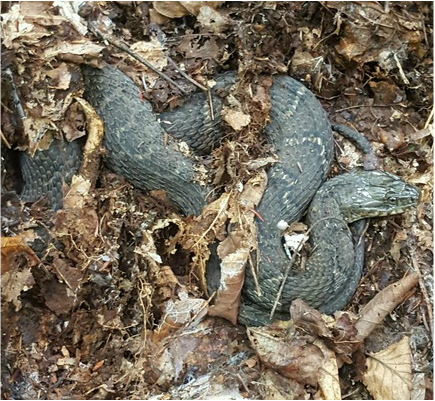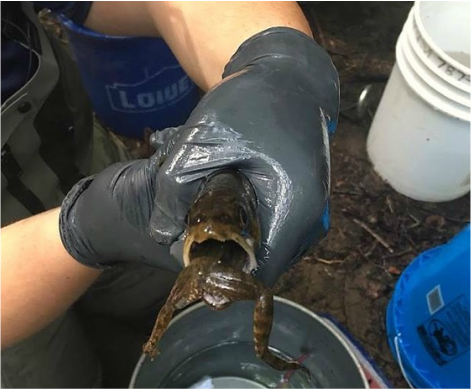 If I had to run into a snake, at least it was just a water snake. Typically fairly aggressive, but not when it's cold. If I had to run into a snake, at least it was just a water snake. Typically fairly aggressive, but not when it's cold. Monday was a day I had been dreading for some time. With the fish tagged and recovered, Dan and I hit the streams trying to locate all the new brook trout we recruited into the study (calling them recruits makes it sound like they had a choice in this matter. They, of course, did not.). In the summer, I had basically memorized the location of every fish and they rarely moved. So, tracking was as simple as walking to the fish, fine-tuning the location, and entering the data into the GPS. Now, with 60 more tags, higher stream flows, and movement for spawning season, I have to assume none of the fish are where they were last time. Plus, tags are spread across six frequencies, so it takes a lot more focus and time. But, we tentatively set the next sample date for mid-November, which will also signify the end of fall telemetry. Just keep tracking. The job did get marginally easier, though. We found a few dropped tags which had signs of mammalian predation (teeth marks). We also finally did what I hoped we would never do- tracked a tag into a snake. I had walked around the tag all morning because I was struggling to get a good signal. This should have been the first tip that it was out of the water. I’ve learned that consistently weak signals are usually the result of pointing the antenna in the wrong direction (i.e., only focusing my attention on the stream, and not the banks. Because fish don’t usually wind up land. Keyword: Usually). Right as we were leaving I finally got a signal strong enough to follow and we scampered up a steep slope trying to hone in on the signal. I was traipsing around a tiny area, wondering why I couldn’t get the signal higher. Dan was starting to wipe leaves away looking for the tag when, you guessed it, he pawed right over the snake. The snake definitely wasn’t happy to see us, but thankfully it was a cold morning or otherwise one of us would have surely gotten bitten.  Fish rely on the land for more than just bugs. Here is a brook trout we caught during tagging attempting to eat a frog. I find this feat a little more impressive that the snake. Fish rely on the land for more than just bugs. Here is a brook trout we caught during tagging attempting to eat a frog. I find this feat a little more impressive that the snake. Lost tags are always a little frustrating. The analyses we hope to complete are very data hungry, meaning every fish counts. That said, dropped tags, particularly tags that end up in odd locations, always spark some curiosity. What happened to the fish, and how did the tag end up where we found it? Sometimes I’m curious because we find the tag really far away; much further than it should have traveled in two days. Other times we find tags next to a nest of fishing line (not so hard to figure out what happened to that fish, but I do wonder want the angler thought when they saw the antenna. Robofish?). When I find a tag with clear signs of predation, it really reminds me that streams aren’t isolated habitats. Fish biologists spend a lot of time with their eyes in the water and it’s sometimes easy to forget that aquatic and terrestrial habitats are intimately connected. The bugs on the land feed the fish, and the fish feed the land animals (among other things). It’s a tight food web that, if interrupted, can really collapse entire ecosystems. This example was set by 4-foot snake that gobbled up a 7.5-inch trout. An impressive feast. And, the only question that remains for me is how the snake feels about having that transmitter pass through its digestive system. We were hoping to track on Friday, but Pennsylvania is currently under a black cloud of rain. Hopefully it eases up by Monday and the fish will have done something interesting. In case you missed it, be sure to check out our special on Pennsylvania Outdoor Life (videos can be found by clicking here). A special thanks to anyone who left comments or feedback, I’ll return all your messages soon! And, if you’re in the area, mark your calendars for October 12th at 7 pm when I’ll be giving a presentation to the Susquehanna Chapter of Trout Unlimited. Come hear more about my research and some early results that are rolling in.
3 Comments
Scott Minnier
10/7/2016 12:57:56 pm
Thank you for all the work you folks are doing! I watched the WNEP PA Outdoor Life coverage of your project and decided to visit Shanersburg once again. I am a Sullivan Co. native and have fished almost all the waters in the county at one time or another. It's been two decades since I've stepped into the Shanersburg's water & I truly enjoyed it. The weather was perfect and I had the place to myself. Just about every spot I tried in the creek produced fish, and I managed to haul in two of the tagged brookies. They appeared to be in good shape but on the skinny side. The water level is very low and I believe food is scarce for them at this time. I even had a couple of small ones that were not hooked, but would not let go of the worm!
Reply
1/24/2020 07:59:05 pm
I really do think that animals just eat everything. Well, I had been on a farm once, so I was able to observe a lot of them. I think that if we do not manage to go and study them, then we will not understand how their brains work. I want to see how an animal thinks. I want data that would allow me to go and think about what kind of a species animals are, I really do feel that way.
Reply
11/5/2019 05:46:23 pm
The only downside of traditional braided lines is that they may be more visible to bass than monofilament or fluorocarbon. In heavy cover or low light conditions, though, that probably doesn’t matter.
Reply
Leave a Reply. |
AuthorShannon White Archives
October 2018
Categories
All
|
The Troutlook
A brook trout Blog
Proudly powered by Weebly
 RSS Feed
RSS Feed